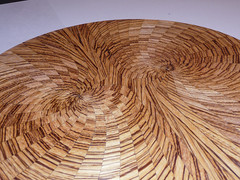Testing the Ephemerisle game platform
Jun. 6th, 2010 06:08 pmI built a rough scale model of one of the Ephemerisle art projects I've been doing. Yesterday my project partner ![[livejournal.com profile]](https://www.dreamwidth.org/img/external/lj-userinfo.gif) papertygre and I tested out the gameplay.
papertygre and I tested out the gameplay.
The model is on a pile of foam that allows us to simulate tilting of the platform on the water. We're moving our weight around to tilt the platform and influence the movement of the ball -- I'm trying to get it into the white holes, while she's trying to get it into the purple holes. Since our weights differ substantially, she's wearing a backpack with a heavy weight in it to balance us out:


And a video of gameplay:
The full size version will be a floating square platform 8ft in size. We're planning on building out several different "skins", different games that can be attached to the same floating platform. If you're interested in building your own skin, let us know.
The model is on a pile of foam that allows us to simulate tilting of the platform on the water. We're moving our weight around to tilt the platform and influence the movement of the ball -- I'm trying to get it into the white holes, while she's trying to get it into the purple holes. Since our weights differ substantially, she's wearing a backpack with a heavy weight in it to balance us out:


And a video of gameplay:
The full size version will be a floating square platform 8ft in size. We're planning on building out several different "skins", different games that can be attached to the same floating platform. If you're interested in building your own skin, let us know.
























































